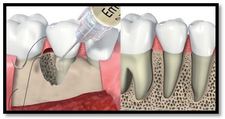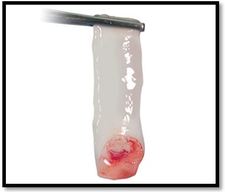

Patients who have suffered tooth loss, periodontal disease, or is considering implant placement, often require some form of bone regeneration as part of their corrective treatment.

|
When we lose teeth, there is no longer anything stimulating the bone to keep it there and bone resorption takes place. In some cases the bone is too far resorbed and cannot be rebuilt, but in most cases bone can be replaced. To see how much bone is needed in an area, a CBCT (Cone beam CT 3D) x-ray is usually taken during the consultation. This will give us a good indication of how much bone there is in an area especially when implants are considered, and in the Maxilla (top jaw), it also indicates if sinus lift procedures will be necessary to create adequate bone height for implant placement. |
When a sinus lift is needed to create bone height in the upper jaw, a bone putty may be used as it is more pliable; however, in tooth sites, a bone granulate is generally used to build up the jaw bone.

|
When a tooth is extracted the conventional way, most often the bone that surrounded the tooth is damaged and some of the bone structure removed along with the tooth. With a surgical removal, the ligament that binds the tooth to the bone structure is gently loosened with a special instrument, allowing for the tooth to be removed in such a way as to preserve as much of the bone structure as possible. A bone granulate of animal origin, is placed in the socket where the tooth was extracted. T |
Although we find in most cases that bone augmentation is needed, it is not always the case. The need for bone augmentation is however identified by the CBCT scan and varies from case to case.
During periodontal disease, especially if it has progressed from gingivitis to periodontitis, the bone surrounding the teeth is eaten away by bacteria. This bone can be replaced during a surgical deep cleaning, by placing a bone regenerative gel, called Emdogain, into the bone defect sites. This gel is the only product of its kind and stimulates the cells on the tooth root to form new bone and periodontal ligament in the defect areas over a period of 9 – 12 months. |
 |
 |
A-PRF (Advanced Platelet Rich Fibrin) is therapy using leukocytes and platelet-rich fibrin to promote wound and bone healing. The function of the leukocytes is to support the immune response, and the slow release of properties of the A-PRF have the advantage of allowing a constant release of growth factors and matrix proteins over 7 days. During a procedure, blood may be extracted from a patient, which is spun in a centrifuge for 8 minutes. This process separates the growth factors from the rest of the blood, which form a jelly-like substance. This substance is then compressed into a plaster-like membrane. |
The growth simulators can be used and applied in locations where growth and cell activation are to be stimulated, such as where bone augmentation or soft tissue grafting has been done. These growth factors stimulate fibroblasts - cells in connective tissue which produces collagen and other fibres - which in turn stimulate the formation of collagen.
The use of A-PRF during our surgeries have shown a marked improvement in the healing process and patients report having far less discomfort in surgical sites.